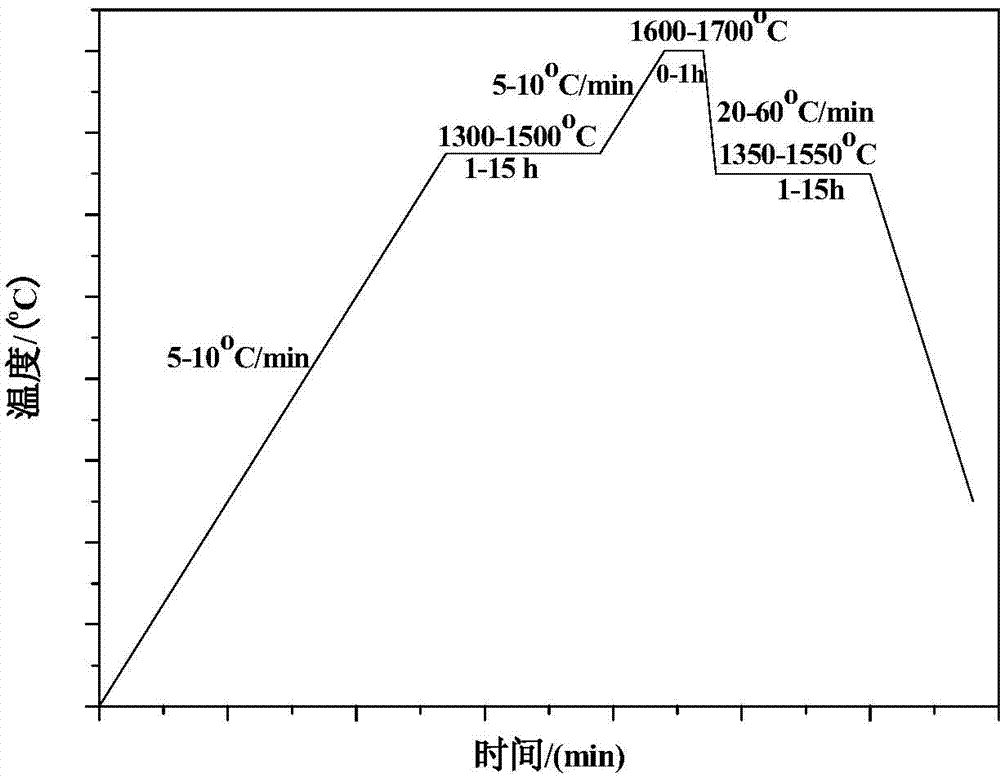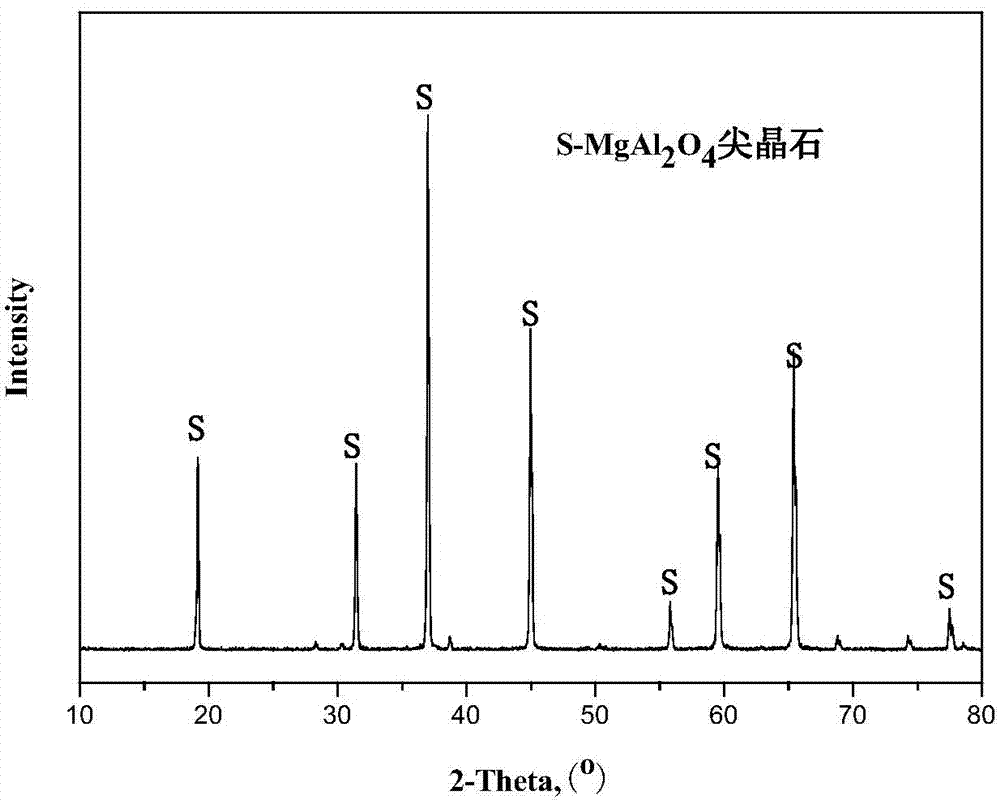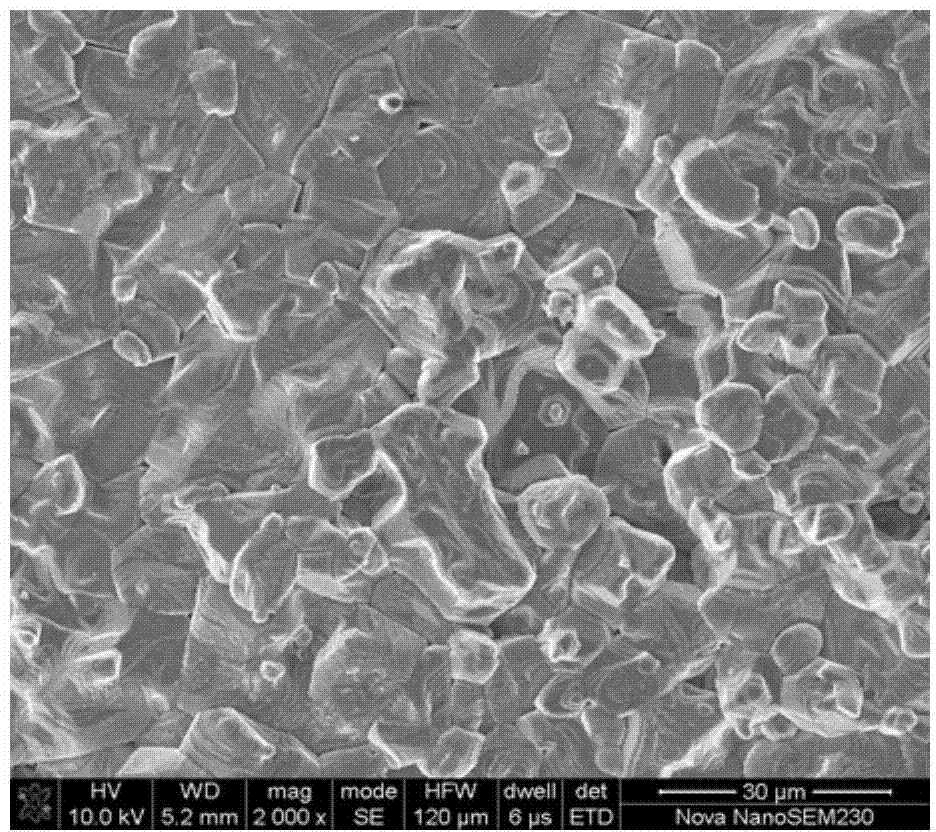Reactive sintering method for preparing magnesia alumina spinel
A technology of magnesia-aluminum spinel and sintering method, which is applied in the field of reaction sintering for preparing magnesia-aluminum spinel, can solve the problems of short sintering time, high calcination temperature, uneven particles, etc., and achieves short holding time at high temperature and microstructure Uniform and simple preparation process
- Summary
- Abstract
- Description
- Claims
- Application Information
AI Technical Summary
Problems solved by technology
Method used
Image
Examples
Embodiment 1
[0026] Magnesium oxide with an impurity content of 4wt.% and alumina with an impurity content of 1wt.%, according to MgO:Al 2 O 3 The molar ratio is 1:1. The ball milled for 1 hour at a speed of 10r / min and a ball-to-battery ratio of 1:1. The powder obtained by ball milling is held at 50 MPa for 1 min, and the green body is molded at 120°C. Dry at temperature. Place the dried green body in a box-type resistance furnace, heat it up to a temperature of 1300°C at a heating rate of 5°C / min for 2 hours, and then heat it to a temperature of 1600°C at a heating rate of 5°C / min 0.1h, then at a cooling rate of 30°C / min, the temperature is reduced to 1350°C for 2 hours, and then cooled naturally to room temperature. The resulting magnesium aluminum spinel ceramic has a density of 93% and a bending strength of 150 MPa.
Embodiment 2
[0028] Magnesium raw material mixed with magnesium hydroxide and magnesium oxide with an impurity content of 3wt.%, and aluminum raw material mixed with aluminum carbonate and alumina with an impurity content of 2wt.%, according to MgO:Al 2 O 3 The molar ratio is 1:1, and the ball milled for 4 hours at a speed of 30r / min and a ball-to-battery ratio of 2:1. The powder obtained by ball milling is held at 100MPa for 5 minutes, and the green body is pressed at 120℃. Dry at temperature. Place the dried green body in a box-type resistance furnace, heat it up to a temperature of 1400°C at a heating rate of 8°C / min for 2 hours, and then heat it to a temperature of 1650°C at a heating rate of 8°C / min 0.5h, then at a cooling rate of 40℃ / min, the temperature is lowered to 1450℃ for 5h, and then cooled naturally to room temperature. The obtained magnesium aluminum spinel ceramic has a density of 96% and a bending strength of 180 MPa.
Embodiment 3
[0030] Magnesium raw material mixed with magnesium hydroxide and magnesium carbonate with an impurity content of 2wt.%, and aluminum raw material mixed with aluminum carbonate and aluminum hydroxide with an impurity content of 3wt.%, according to MgO:Al 2 O 3 The molar ratio is 1:1, and the ball milled for 8 hours at a speed of 60r / min and a ball-to-battery ratio of 3:1. The powder obtained by ball milling is held at 150MPa for 8min, and the green body is molded at 120℃. Dry at temperature. Place the dried green body in a box-type resistance furnace, heat it up to 1450°C at a heating rate of 10°C / min for 10 hours, and then heat it to a temperature of 1680°C at a heating rate of 10°C / min 0.8h, then at a cooling rate of 50℃ / min, the temperature is lowered to 1500℃ for 10h, and then cooled naturally to room temperature. The obtained magnesium aluminum spinel ceramic has a density of 98% and a bending strength of 200 MPa.
PUM
| Property | Measurement | Unit |
|---|---|---|
| density | aaaaa | aaaaa |
| bending strength | aaaaa | aaaaa |
| bending strength | aaaaa | aaaaa |
Abstract
Description
Claims
Application Information
 Login to View More
Login to View More - R&D
- Intellectual Property
- Life Sciences
- Materials
- Tech Scout
- Unparalleled Data Quality
- Higher Quality Content
- 60% Fewer Hallucinations
Browse by: Latest US Patents, China's latest patents, Technical Efficacy Thesaurus, Application Domain, Technology Topic, Popular Technical Reports.
© 2025 PatSnap. All rights reserved.Legal|Privacy policy|Modern Slavery Act Transparency Statement|Sitemap|About US| Contact US: help@patsnap.com



